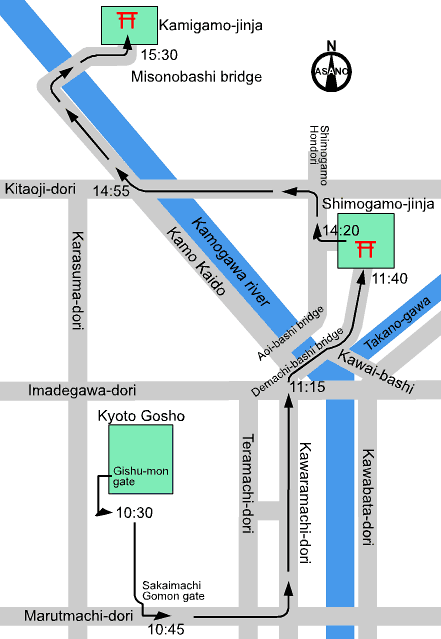
Aoi Matsuri
Date: 15 May
This festival is also known as the Kamo Festival, and is held at both the Kamigamo and Shimogamo Shrine. The origin of the festival dates back to the time of the Kinmei Emperor (approximately 1400 years ago). The grain at the time was not ripening, and this was seen as a curse from the Kamo-god. A horse was made to run with bells attached, and an abundant harvest resulted. This tradition continued unbroken, and came to be celebrated on a grand scale from the Fujiwara era.
The name of the Aoi Festival originated from the tradition of offering geraniums (aoi) to the gods, and decorating the temple, attendees and ox carriages with geranium leaves. Wearing elegant costumes of the Ochoera, the refined charm of the envoy and public servants parading through the city represents old-style Kyoto.
Simplified route map of procession
Please note that the times shown in the following map are approximation. The precession may go earlier or later than the times shown. Also, the simplified map is not to scale.

- ACTIVITIES
- Washoku Cooking
- Archery Lesson
- Calligraphy
- Cinema
- Nara Farm Project
- Flower Arranging
- Food Tasting
- Funaokyama
- Garden Walk
- Guided Tours
- Home Visit
- Heian Imperial Costume Studio
- Children Kimono/Yukata Dress up
- Koto Lesson
- Kyoto Handicraft Center
- Lacquerware Lesson
- Lantern Making
- Meditation
- Museums
- Nishijin Textile Center
- Pickle Tasting
- Pottery
- Public Baths
- Roketsu/Indigo Dyeing
- Saké Tasting
- Samurai
- Shiatsu
- Temple Stamp – Goshuuin
- Toyouke No Mori – Nara Farm Project
- Special Sidetrips
- Taiko
- Tea Ceremony
- Tatami Making
- Theater
- Time with Artisans
- Time with Geisha/Mieko
- Walking/Hiking
- Woodblock-Making Workshops
- Yoga/Lunch
- Rainy Day Activities
- Special Events
Traditional Kyoto • P O Box 1636 • Langley, Washington 98260
Penny Kaela Bauer • info@traditionalkyoto.com
Much more to see at www.thegiftsproject.com
site by graysonwebdesign.com • RSS Feed • Log in
Copyright © 2025 • All Rights Reserved
